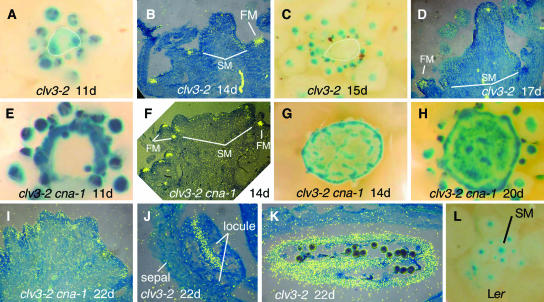Figure 6.
WUS Expression in Inflorescences of clv3-2 and clv3-2 cna-1 Plants.
Detection of PWUS:GUS expression ([A], [C], [E], [G], [H], and [L]). Photographs were taken from above the apices, showing GUS activity in blue. Detection of WUS mRNA using 35S-labeled probes in longitudinal sections ([B], [D], [F], [I], [J], and [K]). WUS mRNA signal is shown in yellow. SM, shoot meristem; FM, floral meristem.
(A) The apex of an 11-d-old clv3-2 plant. The meristem is outlined in white. Note the lack of GUS signal in most of the shoot apical meristem.
(B) The apex of a 14-d-old clv3-2 plant. Note the robust expression within flower meristems, whereas the shoot apical meristem lacks robust signal.
(C) The apex of a 15-d-old clv3-2 plant. The meristem is outlined in white.
(D) The apex of a 17-d-old clv3-2 plant.
(E) The apex of an 11-d-old clv3-2 cna-1 plant. Note the robust GUS signal around the periphery of the meristem and within the flower meristems both outside and inside the ring. The signal at the bottom of the ring is obscured by a leaf.
(F) The apex of a 14-d-old clv3-2 cna-1 plant. Note the robust expression within flower meristems, whereas the shoot apical meristem lacks robust signal.
(G) The apex of a 14-d-old clv3-2 cna-1 plant. Note the ring of GUS signal around the periphery.
(H) The apex of a 20-d-old clv3-2 cna-1 plant. Note the increase in GUS signal across the center of the apex associated with differentiation.
(I) The apex of a 22-d-old clv3-2 cna-1 plant. Note the pockets of WUS signal.
(J) Developing anther of a 22-d-old clv3-2 plant.
(K) Older anther of a 22-d-old clv3-2 plant.
(L) The apex of a wild-type Ler plant shortly after the transition to flowering.

